Life Cycle Assessment of District Heating Systems in Europe: Case Study and Recommendations
Abstract
:1. Introduction
- Conduct a holistic analysis of life-cycle environmental impacts in several scenarios of district heating systems;
- Compare decentralized systems (in buildings) to centralized district heating systems;
- Identify the main sources of the environmental impacts of different heating production system scenarios used in district heating networks, over and above climate change, and the levers for more sustainable heating production.
2. Materials and Methods
2.1. Goal and Scope of the Functional Unit
- function: deliver the final demand of heat for a specific neighborhood detailed below;
- quantity: 110 GWh of delivered heat in a typical neighborhood (based on [35] and on internal experts to fit for an extension of a DHC in a neighborhood planning development [36]), composed of 40% for old collective housing buildings, 30% for new collective housing buildings and 15% each for new and old office buildings;
- timeline: one year of fulfilling heat demand for current technologies;
- quality: as high as possible in a 4th generation district heating (4GDH) system when considering a DHS.
- one or more heating source for the main function, a complement and a back-up to cover high-heating-demand periods and supply issues, to bridge power failures and to ensure continuous heat delivery. Decentralized (individual) systems had neither complements nor back-up installations;
- networks and substations for every connected building.
- climate change (100 years), excluding land use change and biogenic carbon, expressed in in kg CO2 equivalent;
- photochemical ozone creation potential (POCP), expressed in kg NMVOC equivalent;
- respiratory inorganics, expressed in disease incidence;
- acidification, expressed in mol H+ equivalent;
- eutrophication of freshwater, expressed in kg P equivalent;
2.2. System Boundaries
2.3. Temporal and Geographical Scope
- is the maximal needed power for heating in the considered building (in MW);
- is the maximal needed power for domestic hot water in the considered building (in MW);
- is the diversity factor;
- is the safety coefficient;
- is the leak rate (substation and network, in percentage).
- Tref is the required temperature for heating: 18 °C;
- Text is the minimal external temperature (°C);
- HDD is the heating degree days of the considered area (°C∙d);
- C is the annual heating consumption of the building (in MWh);
- i is the intermittence coefficient, which corresponds to the heating system setpoint temperature variations.
- is the difference between the reduced temperature setpoint and the standard setpoint (°C);
- is the number of hours during which the setpoint was reduced (8 h in residential buildings and 12 h in offices considered);
- is the number of days in the heating period, varying between 100 and 250 days according to the area and the type of building);
- the maximal needed power for domestic hot water, , is given by Equation (4) [45] (in MW):where:
- c is annual domestic hot water (DHW) consumption (in m3);
- Q is the energy needed to heat 1 m3 (in MWh/m3);
- h is the number of daily hours when the hot water tank heating is needed.
3. Life Cycle Inventory
3.1. Fuel Supply: Main Fuel and Complement
3.2. Heat Production: Main and Complement Heat Downstream
- conventional boilers, which represent most of the existing stock for standalone solutions;
- condensing boilers, which have the same basic properties as conventional boilers but include lower fume temperatures to cause condensation and thus recover latent heat. This kind of equipment has a much higher yield than a conventional boiler; the yield may be even higher than 100% of the lower heating value (LHV).
- The nominal efficiency after one year of installation for an average 100 kW condensing boiler was between 95 and 105% and closer to 85–95% for lower temperatures [50,51]. A 15% reduction factor was considered for converting nominal efficiencies to annual ones; this led to considered annual efficiencies of 90% for small condensing boilers and of 80% for small noncondensing boilers.
- The efficiency of larger installations was considered better, as usually, the construction in larger installations is better, the installation is better maintained, the flame is more oxygenized, there is more space to develop and there is better inertia. This meant that, for an average 20 MW unit, the yield could reach around 102–105% on LHV for condensing boilers and 92–97% for noncondensing ones [50,51]. As the installations were considered to be composed of several units to allow a variation of the load, a 5% factor was considered on annual efficiencies. This led to annual efficiencies of 97% for large condensing boilers and 90% for large noncondensing boilers.
3.3. Network Production
3.4. Network and Substation Use
3.5. Infrastructure
4. Results
4.1. Main Impact Category Contributors
- climate change (100 years), excluding land use change and biogenic carbon;
- photochemical ozone creation potential (POCP);
- respiratory inorganics;
- acidification;
- eutrophication freshwater.
4.2. General Insights on District Heating Systems Environmental Performance
4.2.1. Climate Change
4.2.2. Photochemical Ozone Creation Potential (POCP)
4.2.3. Respiratory Inorganics
4.2.4. Acidification
4.2.5. Eutrophication Freshwater
4.2.6. Main Conclusions from the European Case Study
- represented, usually, more modern technology, with more money available and better equipment (filters, etc.);
- received better maintenance, not taken into account in the system boundaries but directly affecting the global efficiency;
- benefitted from scale effects enhancing the modulating capability of the system and thus reaching a much better annual efficiency.
4.3. Sensitivities Analysis
4.3.1. Network Efficiency
4.3.2. The Importance of the Nature and Rate of Complements
4.3.3. The Importance of Biogenic Carbon Accounting for Biomass-Based Scenarios
- There has been no absolute consensus in the literature regarding the way to account for it. For instance, the GHG protocol advised reporting GHG emissions in one section and biogenic CO2 in another. If the timeframe of a study is shorter than 100 years, the underlying assumption of total reabsorption becomes impossible. The Renewable Energy Directive in Europe [64] also considered biofuel use as neutral. However, some countries, such as Canada, have a shorter-term vision and account for the totality of the biogenic CO2 in the same way as fossil CO2.
- The claim of neutrality of biogenic CO2 emissions can only be made when the biomass is sustainably managed and not imported from a country, e.g., deforesting its forests. If the biomass were not sustainably managed, the results for climate change for the less dense habitat in Eastern Europe would look like the graph below Figure 5, i.e., with a complete disadvantage for the biomass-based scenario.
4.3.4. The Importance of Waste Energy Accounting
4.3.5. The Importance of Cogeneration Allocations
- is the allocation factor for heat;
- and are, respectively, the energy of heat and electricity delivered by the process (in MWh);
- and are the reference values for the separated production of heat and electricity, respectively. For natural gas, the ratio of the reference value for heat to the reference value for electricity was 1.7.
- is the energy allocation factor for heat;
- and are the energy, respectively, of the heat and electricity delivered by the process (in MWh).
- is the exergy allocation factor for heat;
- and are the energy, respectively, of the heat and electricity delivered by the process (in MWh);
- and ή are the exergy contents of heat and electricity respectively. In this study, it is considered that the Carnot factor characterizing the exergy content is 1 for electricity and 0.15 for district heating [69].
4.3.6. Data Quality and Limits
5. Conclusions and Discussion
Author Contributions
Funding
Institutional Review Board Statement
Informed Consent Statement
Data Availability Statement
Conflicts of Interest
Nomenclature
| 4GDH | Fourth generation district heat |
| AP | Acidification potential |
| CC | Climate change |
| CHP | Combined heat and power |
| CAPEX | Capital expenditure |
| COP | Coefficient of performance |
| DHS | District heating system |
| DHW | Domestic hot water |
| EF | Eutrophication freshwater |
| EM | Eutrophication marine |
| ET | Eutrophication terrestrial |
| GHG | Greenhouse gas |
| GWP | Global warming potential |
| IR | Ionizing radiation |
| LCA | Life cycle assessment |
| NOx | Nitrogen oxides |
| NMVOC | Nonmethane volatile organic compound |
| OD | Ozone depletion |
| OPEX | Operational expenditure |
| POCP | Photochemical ozone creation potential |
| RI | Respiratory inorganics |
| SOx | Sulfur oxides |
| VOC | Volatile organic compound |
Appendix A
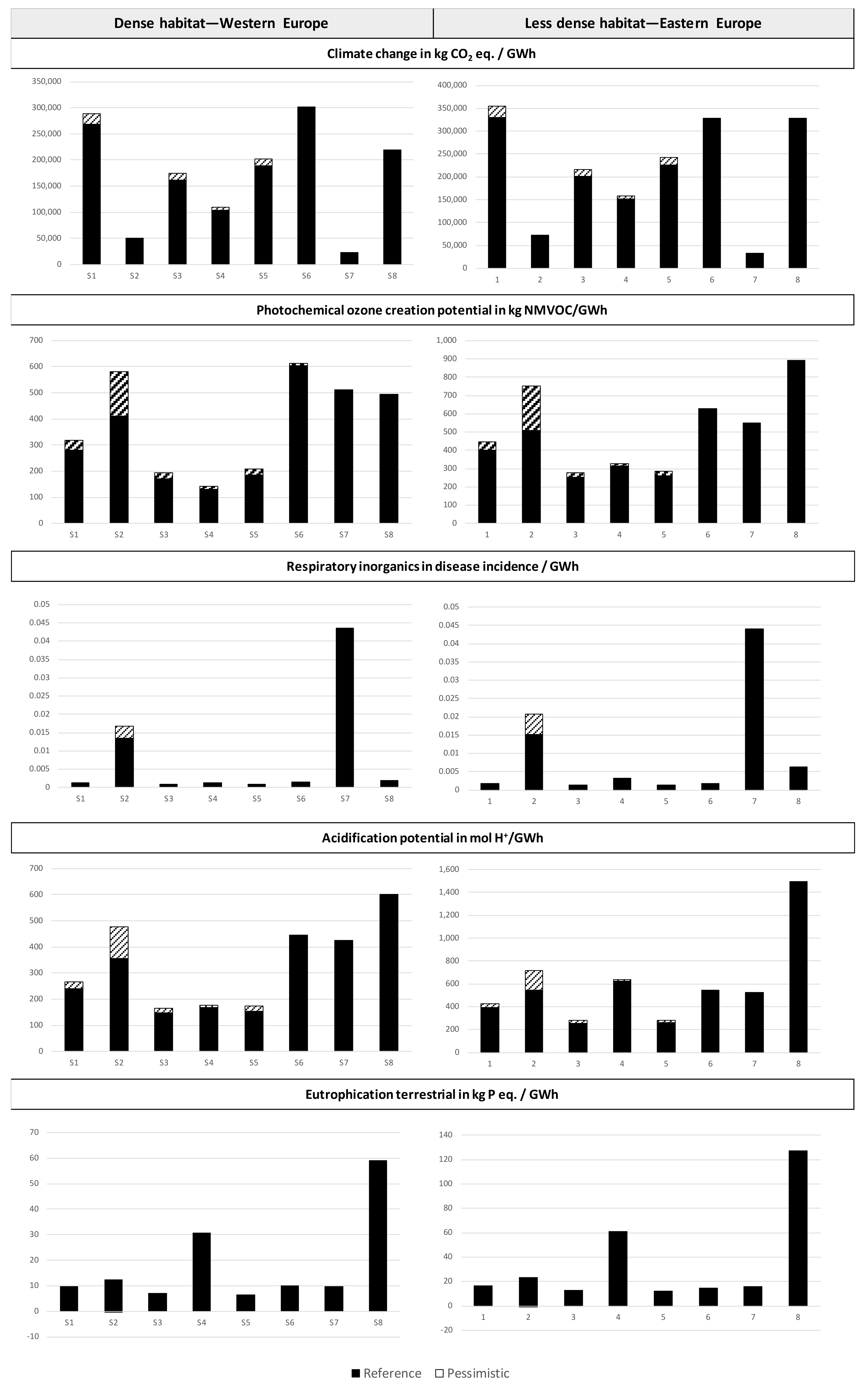
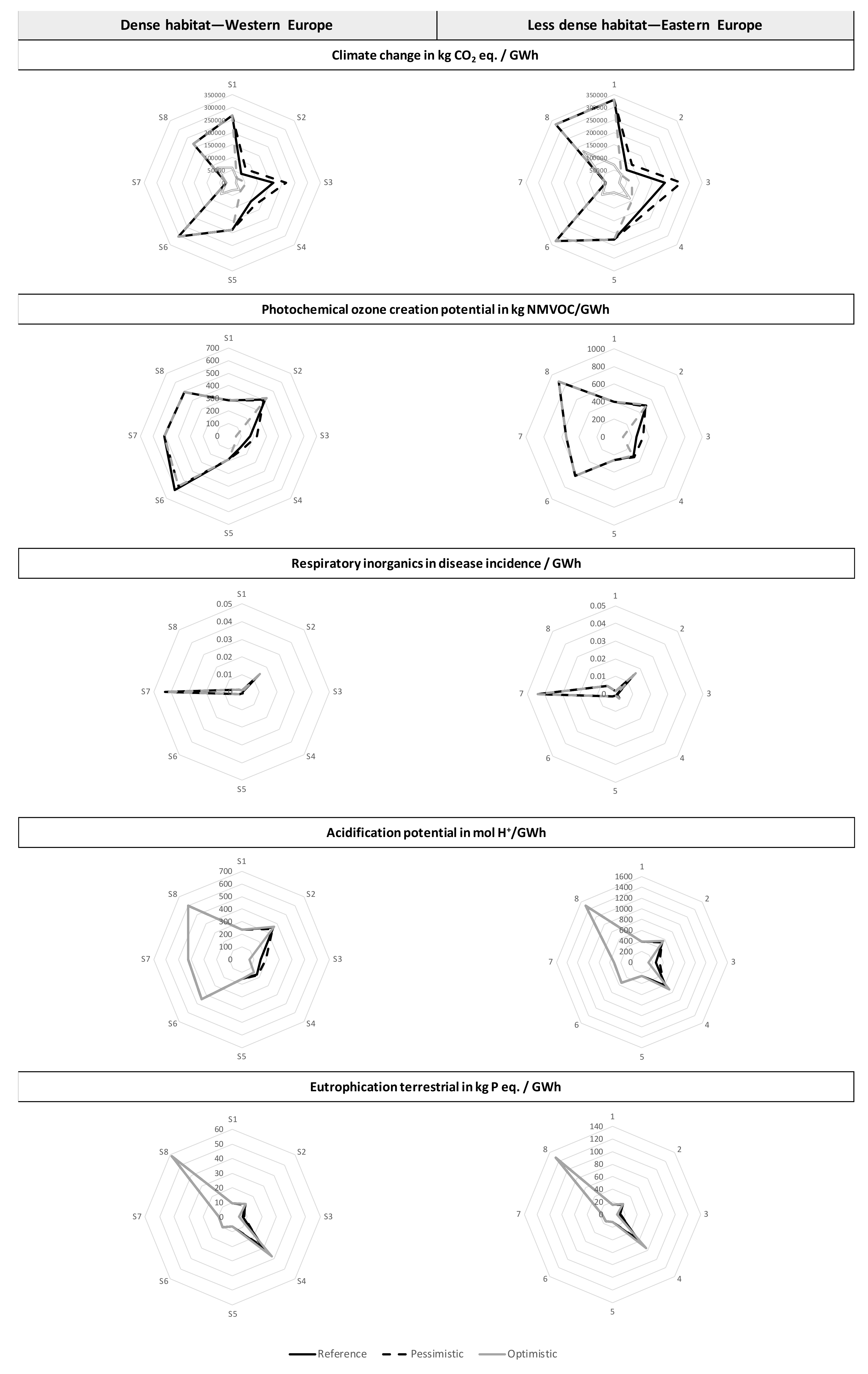
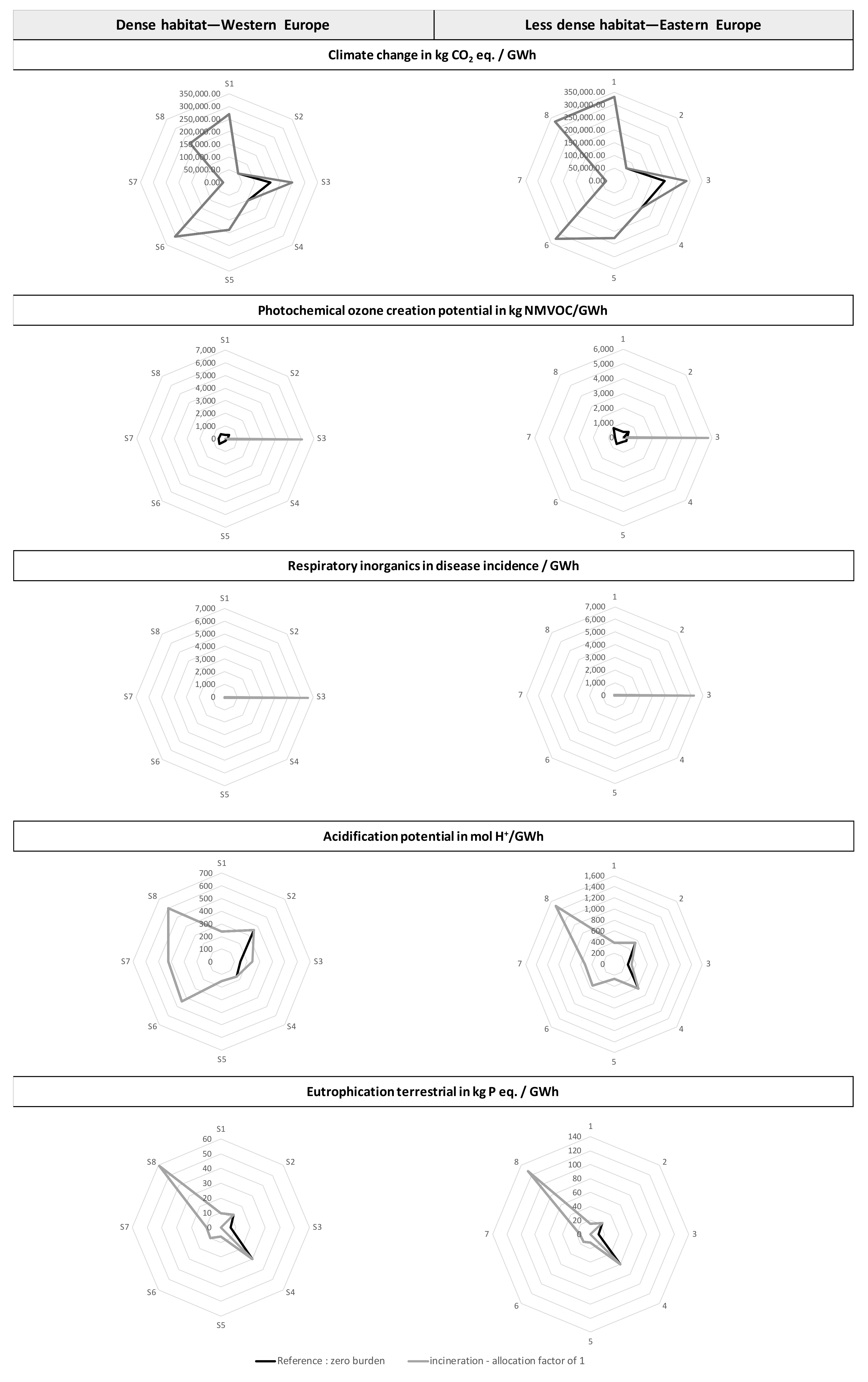
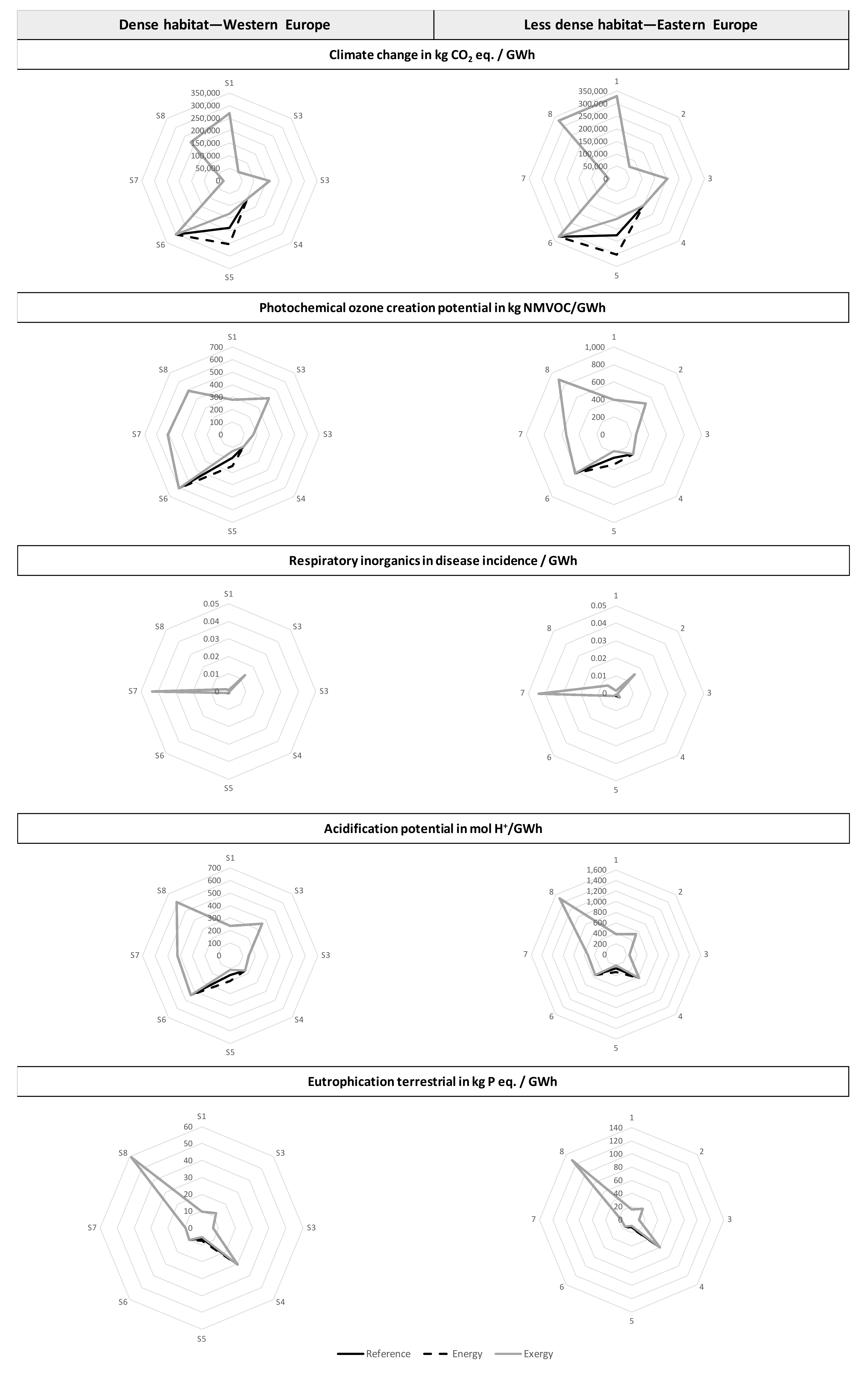
References
- Bartolozzi, I.; Rizzi, F.; Frey, M. Are district heating systems and renewable energy sources always an environmental win-win solution? A life cycle assessment case study in Tuscany, Italy. Renew. Sustain. Energy Rev. 2017, 80, 408–420. [Google Scholar] [CrossRef]
- Werner, S. International review of district heating and cooling. Energy 2017, 137, 617–631. [Google Scholar] [CrossRef]
- Weinberger, G.; Amiri, S.; Moshfegh, B. Investigating techno-economic effects and environmental impacts of energy renovation of residential building clusters on a district heating system. Energy Build. 2021, 251, 111327. [Google Scholar] [CrossRef]
- Sayegh, M.; Danielewicz, J.; Nannou, T.; Miniewicz, M.; Jadwiszczak, P.; Piekarska, K.; Jouhara, H. Trends of European research and development in district heating technologies. Renew. Sustain. Energy Rev. 2017, 68, 1183–1192. [Google Scholar] [CrossRef] [Green Version]
- Mazhar, A.R.; Liu, S.; Shukla, A. A state of art review on the district heating systems. Renew. Sustain. Energy Rev. 2018, 96, 420–439. [Google Scholar] [CrossRef]
- Bayer, P.; Saner, D.; Bolay, S.; Rybach, L.; Blum, P. Greenhouse gas emission savings of ground source heat pump systems in Europe: A review. Renew. Sustain. Energy Rev. 2012, 16, 1256–1267. [Google Scholar] [CrossRef]
- Jäger-Waldau, A.; Kougias, I.; Taylor, N.; Thiel, C. How photovoltaics can contribute to GHG emission reductions of 55% in the EU by 2030. Renew. Sustain. Energy Rev. 2020, 126, 109836. [Google Scholar] [CrossRef]
- Hoekman, S.K.; Broch, A. Environmental implications of higher ethanol production and use in the U.S.: A literature review. Part II—Biodiversity, land use change, GHG emissions, and sustainability. Renew. Sustain. Energy Rev. 2018, 81, 3159–3177. [Google Scholar] [CrossRef]
- Rubio, C.-L.; García-Alcaraz, J.L.; Martínez-Cámara, E.; Latorre-Biel, J.I.; Jiménez-Macías, E.; Blanco-Fernández, J. Replacement of electric resistive space heating by a geothermal heat pump in a residential application—Environmental amortisation. Sustain. Energy Technol. Assessments 2020, 37, 100567. [Google Scholar] [CrossRef]
- Caserini, S.; Livio, S.; Giugliano, M.; Grosso, M.; Rigamonti, L. LCA of domestical and centralized biomass combustion-the case of Lombardy (Italy). Biomass Bioenergy 2010, 34, 474–482. [Google Scholar] [CrossRef]
- Björnebo, L.; Spatari, S.; Gurian, P.L. A greenhouse gas abatement framework for investment in district heating. Appl. Energy 2018, 211, 1095–1105. [Google Scholar] [CrossRef]
- Ghafghazi, S.; Sowlati, T.; Sokhansanj, S.; Bi, X.; Melin, S. Particulate matter emissions from combustion of wood in district heating applications. Renew. Sustain. Energy Rev. 2011, 15, 3019–3028. [Google Scholar] [CrossRef]
- Miralles, J.A.L.; García, R.L.; Carnicero, J.M.P.; Martínez, F.J.R. Comparative study of heat pump system and biomass boiler system to a tertiary building using the Life Cycle Assessment (LCA). Renew. Energy 2020, 152, 1439–1450. [Google Scholar] [CrossRef]
- Parajuli, R.; Løkke, S.; Østergaard, P.A.; Knudsen, M.T.; Schmidt, J.H.; Dalgaard, T. Life Cycle Assessment of district heat production in a straw fired CHP plant. Biomass Bioenergy 2014, 68, 115–134. [Google Scholar] [CrossRef]
- Caputo, P.; Ferla, G.; Ferrari, S. Evaluation of environmental and energy effects of biomass district heating by a wide survey based on operational conditions in Italy. Energy 2019, 174, 1210–1218. [Google Scholar] [CrossRef]
- Guojonsdottir, S.R.; Eggertsson, V.; Guomundsdottir, M.; Johannesson, G. Panorama of Available Environmental Assessment Studies and Sustainability Assessment Studies for Geothermal Systems. 2020. Available online: https://www.geoenvi.eu/wp-content/uploads/2019/11/D3.1-Panorama-of-available-environmental-assessment-studies.pdf (accessed on 1 July 2021).
- Paulillo, A.; Cotton, L.; Law, R.; Striolo, A.; Lettieri, P. Geothermal energy in the UK: The life-cycle environmental impacts of electricity production from the United Downs Deep Geothermal Power project. J. Clean. Prod. 2020, 249, 119410. [Google Scholar] [CrossRef]
- Karlsdottir, M.R.; Lew, J.B.; Palsson, H.P.; Palsson, O.P. Geothermal District Heating System in Iceland: A Life Cycle Perspective with Focus on Primary Energy Efficiency and CO2 Emissions. In Proceedings of the 14th International Symposium on District Heating and Cooling, Stockholm, Sweden, 7–9 September 2014. [Google Scholar]
- McCay, A.T.; Feliks, M.E.; Roberts, J.J. Life cycle assessment of the carbon intensity of deep geothermal heat systems: A case study from Scotland. Sci. Total Environ. 2019, 685, 208–219. [Google Scholar] [CrossRef]
- Pratiwi, A.S.; Ravier, G.; Genter, A. Life-cycle climate-change impact assessment of enhanced geothermal system plants in the Upper Rhine Valley. Geothermics 2018, 75, 26–39. [Google Scholar] [CrossRef]
- Blanc, I.; Damen, L.; Douziech, M.; Fiaschi, D.; Manfrida, G.; Parisi, M.L.; Perez Lopez, P.; Ravier, G.; Tosti, L.; Mendecka, B. First Version of Harmonized Guidelines to Perform Environmental Assessment for Geothermal Systems Based on LCA and Non LCA Impact Indicators: LCA Guidelines for Geothermal Installations; European Project GEOENVI Task D3.2., France. 2020. Available online: https://www.geoenvi.eu/wp-content/uploads/2020/07/D3.2_Environmental-impact-and-LCA-Guidelines-for-Geothermal-Installations-v2.pdf (accessed on 1 July 2021).
- Lund, H.; Werner, S.; Wiltshire, R.; Svendsen, S.; Thorsen, J.E.; Hvelplund, F.; Mathiesen, B.V. 4th generation district heating (4GDH). Energy 2014, 68, 1–11. [Google Scholar] [CrossRef]
- Puettmann, M.E.; Lippke, B. Using Life-Cycle Assessments to Demonstrate the Impact of Using Wood Waste as a Renewable Fuel in Urban Settings for District Heating. For. Prod. J. 2013, 63, 24–27. [Google Scholar] [CrossRef]
- Oliver-Solà, J.; Gabarrell, X.; Rieradevall, J. Environmental impacts of the infrastructure for district heating in urban neighbourhoods. Energy Policy 2009, 37, 4711–4719. [Google Scholar] [CrossRef]
- Fröling, M.; Holmgren, C.; Svanström, M. Life cycle assessment of the district heat distribution system. Int. J. Life Cycle Assess. 2004, 9, 130–136. [Google Scholar] [CrossRef]
- Fröling, M.; Svanström, M. Life Cycle Assessment of the District Heat Distribution System—Part 2: Network Construction (11 pp). Int. J. Life Cycle Assess. 2005, 10, 425–435. [Google Scholar] [CrossRef]
- Eriksson, O.; Finnveden, G.; Ekvall, T.; Björklund, A. Life cycle assessment of fuels for district heating: A comparison of waste incineration, biomass- and natural gas combustion. Energy Policy 2007, 35, 1346–1362. [Google Scholar] [CrossRef]
- Persson, C.; Fröling, M.; Svanström, M. Life Cycle Assessment of the District Heat Distribution System. Part 1 to 3. Int. J. Life Cycle Assess. 2006, 11, 437–446. [Google Scholar] [CrossRef]
- Lund, H.; Østergaard, P.A.; Chang, M.; Werner, S.; Svendsen, S.; Sorknæs, P.; Thorsen, J.E.; Hvelplund, F.; Mortensen, B.O.G.; Mathiesen, B.V.; et al. The status of 4th generation district heating: Research and results. Energy 2018, 164, 147–159. [Google Scholar] [CrossRef]
- JRC. Background Report on EU-27 District Heating and Cooling Potentials, Barriers, Best Practice and Measures of Promotion; Luxembourg Publications Office of the European Union, European Union: Luxembourg, 2012. [Google Scholar]
- Genon, G.; Torchio, M.F.; Poggio, A.; Poggio, M. Energy and environmental assessment of small district heating systems: Global and local effects in two case-studies. Energy Convers. Manag. 2009, 50, 522–529. [Google Scholar] [CrossRef]
- (International Organization for Standardization) ISO. ISO 14040:2006: Environmental Management—Life Cycle Assessment—Principles and Framework; ISO: Geneva, Italy, 2006. [Google Scholar]
- (International Organization for Standardization). ISO 14044:2006: Environmental Management—Life Cycle Assessment—Requirements and Guidelines; ISO: Geneva, Italy, 2006. [Google Scholar]
- JRC. LCD Handbook—General Guide for Life Cycle Assessment-Provisions and Actions Steps; Luxembourg Publications Office of the European Union, European Union: Luxembourg, 2010. [Google Scholar]
- ADEME; SOLINNEN; ENGIE Lab CRIGEN; TRACTEBEL. Analyse de Cycle de Vie des Systèmes Renouvelables de Production de Chaud et de Froid Grande Puissance; ADEME: Angers, France, 2020. [Google Scholar]
- Patureau, R.; Tran, C.T.; Gavan, V.; Stabat, P. The new generation of District heating & cooling networks and their potential development in France. Energy 2021, 236, 121477. [Google Scholar] [CrossRef]
- European Commission. Product Environmental Footprint Category Rules Guidance, Version 6.3. 2018. Available online: https://ec.europa.eu/environment/eussd/smgp/pdf/PEFCR_guidance_v6.3.pdf (accessed on 1 July 2021).
- CEREMA. Réseaux de Chaleur—Bases Techniques, 2014. Available online: http://reseaux-chaleur.cerema.fr/wp-content/uploads/140513_bases-techniques-cerema.pdf (accessed on 2 March 2020).
- Minister of Construction and Housing; Minister of Energy. Réglementation Thermique 2012 (RT2012), Arrêté du 26 Octobre 2010 Relatif Aux Caractéristiques Thermiques et Aux Exigences de Performance Energétique des Bâtiments Nouveaux et des Parties Nouvelles des Bâtiments. 2010. Available online: https://www.legifrance.gouv.fr/affichTexte.do?cidTexte=JORFTEXT000022959397&categorieLien=id (accessed on 15 September 2020).
- CPCU. Guide Technique: Le Poste De Livraison Vapeur. 2012. Available online: https://docplayer.fr/163179059-Edition-guide-technique-le-poste-de-livraison-vapeur.html (accessed on 1 September 2021).
- Despres, B. Etude de Faisaibilité et de Dimensionnement d’un Réseau de Chaleur avec Chaufferie Biomasse. 2011. Available online: https://hal.univ-lorraine.fr/hal-02093685/document (accessed on 10 September 2020).
- INDDIGO. Solutions Techniques pour Optimiser les Réseaux de Chaleur dans un Contexte de Développement de Bâtiments Basse Consommation. 2011. Available online: https://cibe.fr/wp-content/uploads/2017/02/51-rct34_optimisationrc.pdf (accessed on 1 March 2020).
- Mertz, T. Optimisation Simultanée de la Configuration et du Dimensionnement des Réseaux de Chaleur Urbains; Université de Pau: Pau, France, 2016. [Google Scholar]
- Lillqvist, R. Energy Efficient Design of District Heating Substations; Arcada: Espoo, Finland, 2017. [Google Scholar]
- AMF; IGD. Indicateurs de Performance pour les Réseaux de Chaleur et de Froid. 2009. Available online: https://amorce.asso.fr/publications/indicateurs-de-performance-pour-les-reseaux-de-chaleur-et-de-froid-rct31/download (accessed on 1 July 2020).
- European Commission. Directive (Eu) 2018/844 of the European Parliament and of the Council. 2018. Available online: https://eur-lex.europa.eu/legal-content/EN/TXT/PDF/?uri=CELEX:32018L0844&from=EN (accessed on 1 March 2021).
- Heat Network Partnership for Scotland. District Heating Strategy Factsheets—Application of Industrial Waste Heat Recovery. Available online: https://www.districtheatingscotland.com/wp-content/uploads/2017/10/Module-1-Heat-Recovery.pdf (accessed on 1 March 2021).
- Oldfield, T.; Holden, N.M. An Evaluation of Upstream Assumptions in Food-Waste Life Cycle Assessments. In Proceedings of the 9th International Conference LCA of Food, San Francisco, CA, USA, 8–10 October 2014. [Google Scholar]
- Oldfield, T.L.; White, E.; Holden, N.M. The implications of stakeholder perspective for LCA of wasted food and green waste. J. Clean. Prod. 2018, 170, 1554–1564. [Google Scholar] [CrossRef]
- European Commissions Directorate General for Energy. Mapping and Analyses of the Current and Future Heating/Cooling Fuel Deployment; European Commission, European Union: Brussels, Belgium, 2016. [Google Scholar]
- Martinopoulos, G.; Papakostas, K.; Papadopoulos, A.M. A comparative review of heating systems in EU countries, based on efficiency and fuel cost. Renew. Sustain. Energy Rev. 2018, 90, 687–699. [Google Scholar] [CrossRef]
- European Union. Commission Delegated Regulation Reviewing Harmonised Efficiency Reference Values for Separate Production of Electricity and Heat in Application of Directive 2012/27/EU of The European Parliament and of the Council; Official Journal of the European Union; European Union: Brussels, Belgium, 2015. [Google Scholar]
- JRC. Best Available Techniques Reference Document for Large Combustion Plants; Publications Office of the European Union: Luxembourg, 2017. [Google Scholar]
- Limberger, J.; Calcagno, P.; Manzella, A.; Trumpy, E.; Boxem, T.; Pluymaekers, M.P.D.; Van Wees, J.-D. Assessing the prospective resource base for enhanced geothermal systems in Europe. Geotherm. Energy Sci. 2014, 2, 55–71. [Google Scholar] [CrossRef] [Green Version]
- Longa, F.D.; Nogueira, L.P.; Limberger, J.; van Wees, J.-D.; van der Zwaan, B. Scenarios for geothermal energy deployment in Europe. Energy 2020, 206, 118060. [Google Scholar] [CrossRef]
- Nouvel, R.; Cortado, M.; Pietruschka, D. European Mapping of Seasonal Performance of Air-Source and Geothermal Heatpumps for Residential Applications. In Proceedings of the CISBAT 2015 International Conference on Future Buildings and Districts, Lausanne, Switzerland, 9–11 September 2015. [Google Scholar]
- Andric, Y. The Assessment of District Heating Potential in a Context of Climate Change and Building Renovation; Ecole Nationale Supérieure Mines-Télécom Atlantique Bretagne Pays de la Loire: Nantes, France, 2017. [Google Scholar]
- Energy Technology System Analysis Programme. District Heating. 2013. Available online: https://iea-etsap.org/E-TechDS/PDF/E16_DistrHeat_EA_Final_Jan2013_GSOK.pdf (accessed on 1 July 2020).
- Guest, G.; Bright, R.M.; Cherubini, F.; Michelsen, O.; Strømman, A.H. Life Cycle Assessment of Biomass-based Combined Heat and Power Plants. J. Ind. Ecol. 2011, 15, 908–921. [Google Scholar] [CrossRef]
- UNICLIMA. UNIC-00022-V01.01-FR—Chaudière à Condensation Gaz Collective Chauffage Seul; PEP Ecopassport: Paris, France, 2018. [Google Scholar]
- UNICLIMA. UNIC-00024-V01.01-FR—Chaudière Biomasse a Granulés de Bois Assurant le Chauffage Seul; PEP Ecopassport: Paris, France, 2018. [Google Scholar]
- UNICLIMA. UNIC-00028-V01.01-FR—Ballon de Stockage d’eau Chaud Sanitaire Collectif; PEP Ecopassport: Paris, France, 2010. [Google Scholar]
- UNICLIMA. Pompe à Chaleur Géothermie Non Réversible de Production de Chaud Collective; PEP Ecopassport: Paris, France, 2019. [Google Scholar]
- European Union. Directive (Eu) 2018/2001 of the European Parliament and of the Council on the Promotion of the Use of Energy from Renewable Sources; Publications Office of the European Union: Luxembourg, 2018. [Google Scholar]
- Guest, G.; Cherubini, F.; Strømman, A.H. The role of forest residues in the accounting for the global warming potential of bioenergy. GCB Bioenergy 2013, 5, 459–466. [Google Scholar] [CrossRef] [Green Version]
- Ilic, D.D.; Eriksson, O.; Trygg, L.; Åberg, M. No zero burden assumption in a circular economy. J. Clean. Prod. 2018, 182, 352–362. [Google Scholar] [CrossRef]
- Persson, U.; Münster, M. Current and future prospects for heat recovery from waste in European district heating systems: A literature and data review. Energy 2016, 110, 116–128. [Google Scholar] [CrossRef] [Green Version]
- European Union. Directive 2012/27/Eu of The European Parliament and of the Council on Energy Efficiency; Official Journal of the European Union; European Union: Luxembourg, 2012. [Google Scholar]
- Turconi, R. Life Cycle Assessment of Electricity Systems; DTU Environment: Kongens Lyngby, Denmark, 2014. [Google Scholar]
- Roux, C. Analyse de Cycle de Vie Conséquentielle Appliquée aux Ensembles Bâtis. Université Paris Sciences et Lettres: Paris, France, 2016. [Google Scholar]
- Tian, Z.; Zhang, S.; Deng, J.; Fan, J.; Huang, J.; Kong, W.; Perers, B.; Furbo, S. Large-scale solar district heating plants in Danish smart thermal grid: Developments and recent trends. Energy Convers. Manag. 2019, 189, 67–80. [Google Scholar] [CrossRef]
- Keçebaş, A. Energetic, exergetic, economic and environmental evaluations of geothermal district heating systems: An application. Energy Convers. Manag. 2013, 65, 546–556. [Google Scholar] [CrossRef]
- Hammar, T.; Levihn, F. Time-dependent climate impact of biomass use in a fourth generation district heating system, including BECCS. Biomass Bioenergy 2020, 138, 105606. [Google Scholar] [CrossRef]
- Torchio, M.F.; Genon, G.; Poggio, A.; Poggio, M. Merging of energy and environmental analyses for district heating systems. Energy 2009, 34, 220–227. [Google Scholar] [CrossRef]
- Pieper, H.; Ommen, T.; Elmegaard, B.; Markussen, W.B. Assessment of a combination of three heat sources for heat pumps to supply district heating. Energy 2019, 176, 156–170. [Google Scholar] [CrossRef]
- Huang, J.; Fan, J.; Furbo, S. Demonstration and optimization of a solar district heating system with ground source heat pumps. Sol. Energy 2020, 202, 171–189. [Google Scholar] [CrossRef]
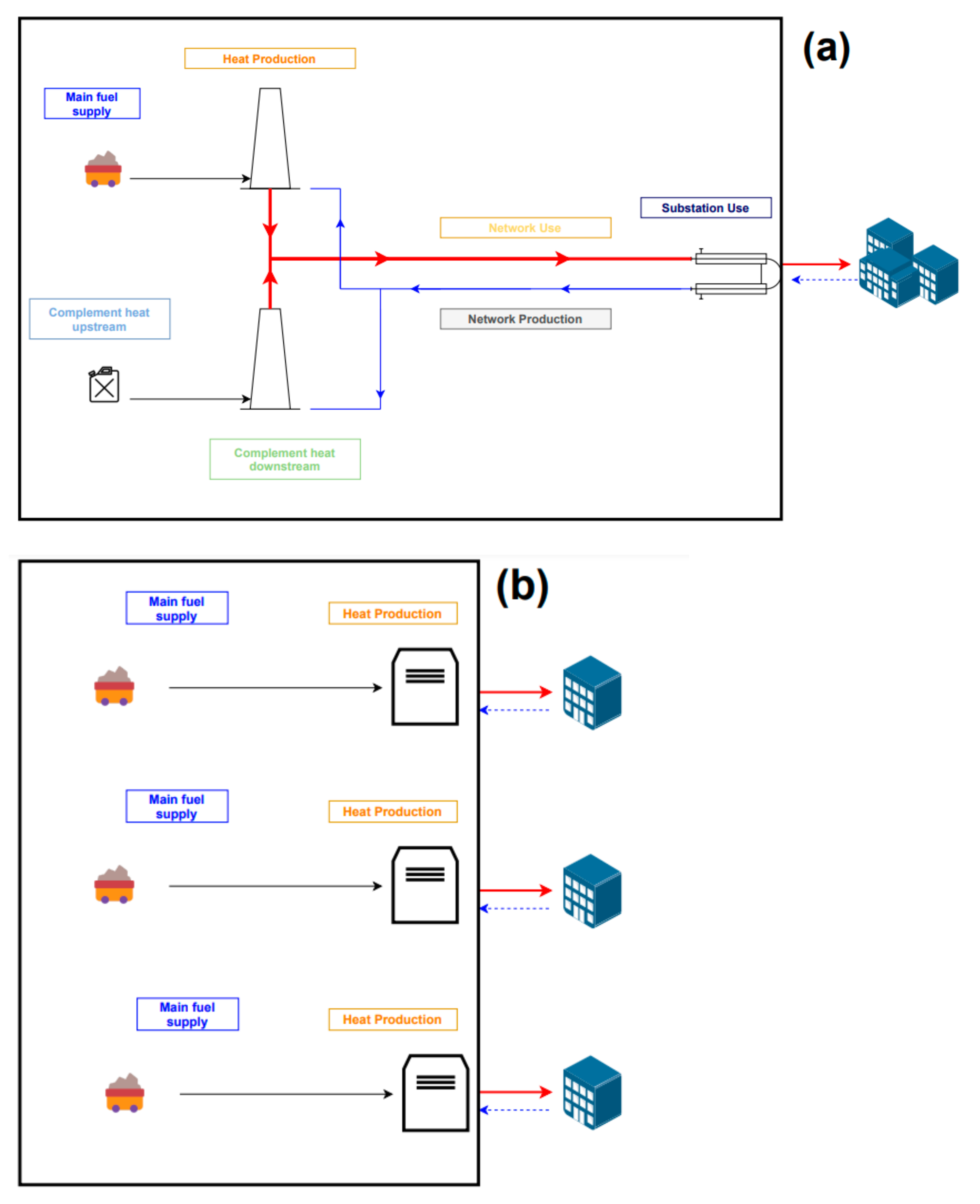
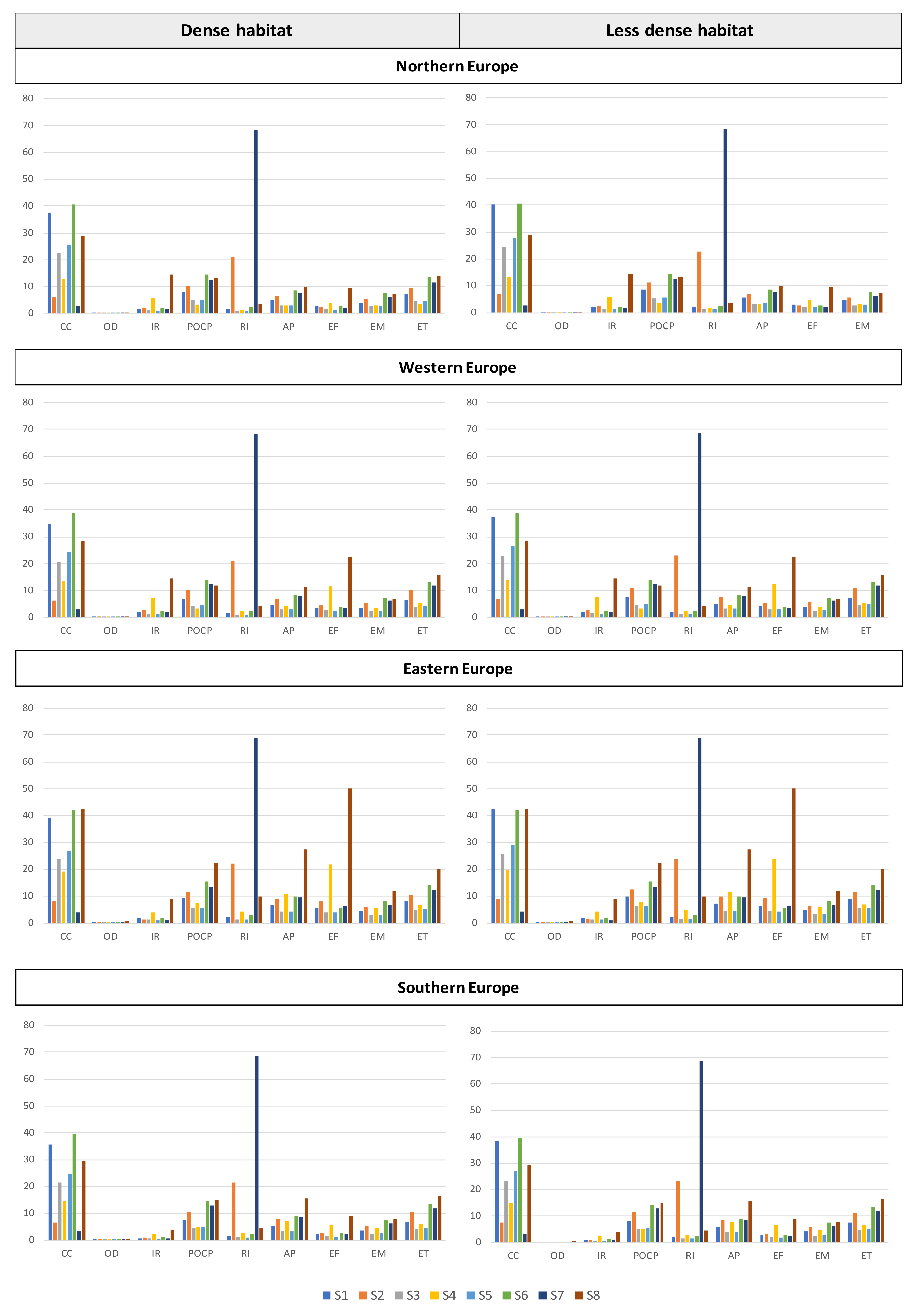

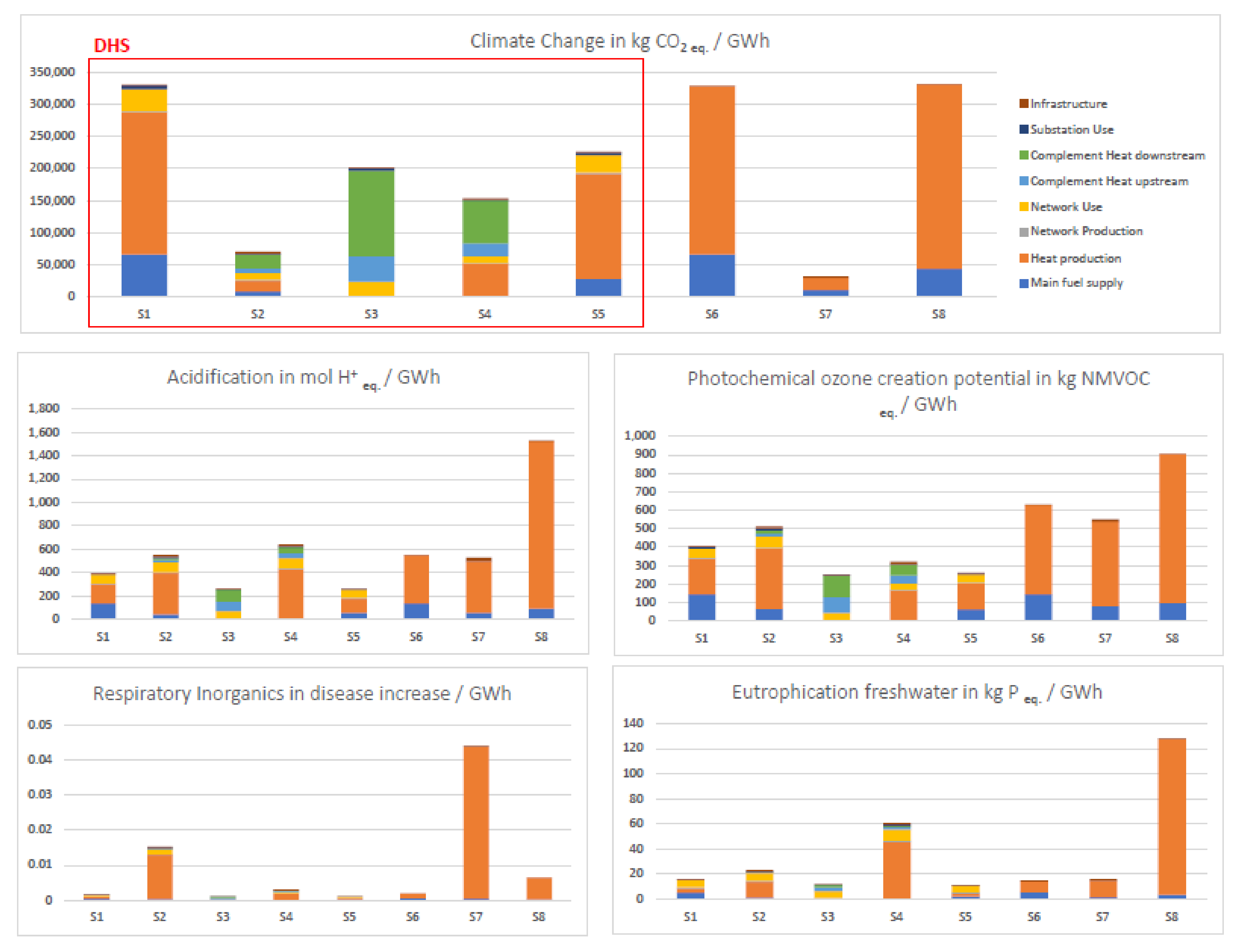
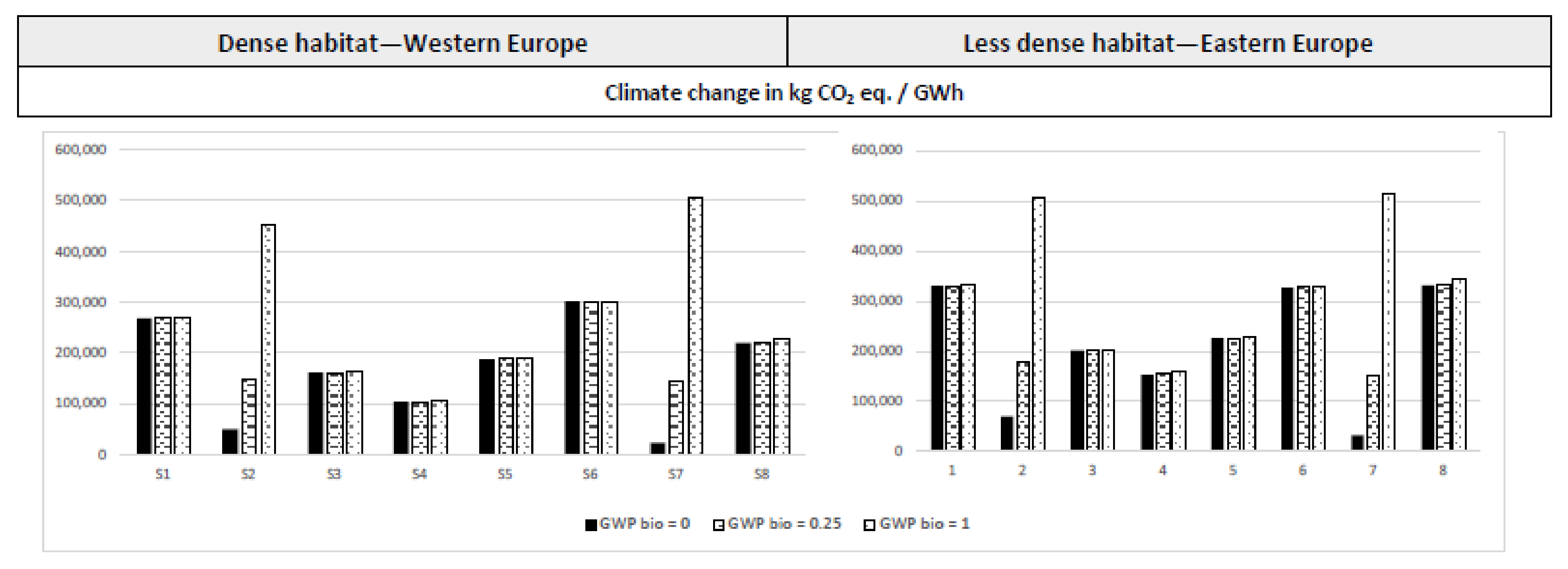
| Scenario | Individual (I) or Collective (C) | Energy Supply | Description |
|---|---|---|---|
| S1 | C | Natural gas | Natural gas district heating system (DHS) |
| S2 | C | Biomass + natural gas | Biomass DHS, with a 10% natural gas complement for peaks and supply shortages |
| S3 | C | Waste industrial heat recovery + natural gas | Waste industrial heat recovery DHS, with a 60% natural gas complement, assuming the energy was available at some precise times of the year (not controllable) |
| S4 | C | Geothermal + natural gas | Geothermal heat for a district heating network with a 30% natural gas complement as analyzed through the viaSeva database, delivered by sorting networks supplying an average of 100 to 120 GWh of heat |
| S5 | C | Natural gas | Natural gas with cogeneration DHS |
| S6 | I | Natural gas | Individual (per building) natural gas heating |
| S7 | I | Biomass | Individual (per building) biomass heating |
| S8 | I | Electricity | Individual (per building) heat pump heating—individual heat pumps are interesting only in low-temperature-equipped buildings, or in other words, in new constructions. Hence, only new buildings (residential and offices) were considered to be equipped with such a system. Other buildings in the neighborhood were equipped with natural gas heating systems with noncondensing boilers. This scenario was thus composed with a 55% heat pump–45% noncondensing natural gas boiler repartition for the neighborhood, analyzed through the functional unit |
| North Europe | South Europe | West Europe | East Europe |
|---|---|---|---|
| Finland | Spain | France | Slovakia |
| Sweden | Portugal | Germany | Estonia |
| Denmark | Italy | Belgium | Poland |
| North | South | West | East |
|---|---|---|---|
| 4601 | 1599 | 2668 | 3574 |
| High Density | Low Density | |||||||
|---|---|---|---|---|---|---|---|---|
| North Europe | East Europe | West Europe | South Europe | North Europe | East Europe | West Europe | South Europe | |
| Installed power in MW for district scenarios (S1–S5) | 72 | 78 | 83 | 92 | 78 | 89 | 93 | 102 |
| Coal and Lignite | Oil | Natural Gas | Biofuels | Nuclear | Hydro | Solar PV | Wind | Waste | Other Sources | ||
|---|---|---|---|---|---|---|---|---|---|---|---|
| Northern Europe | 12% | 0% | 16% | 8% | 20% | 17% | 1% | 15% | 2% | 7% | |
| Southern Europe | 18% | 4% | 21% | 4% | 7% | 22% | 3% | 15% | 1% | 5% | |
| Western Europe | 17% | 1% | 11% | 4% | 43% | 6% | 3% | 6% | 2% | 7% | |
| Eastern Europe | 48% | 12% | 3% | 6% | 18% | 6% | 1% | 3% | 0% | 3% | |
| Europe Zone | Country | Network | Depth (m) |
|---|---|---|---|
| South | Italy | Vincenza | 2130 |
| East | Poland | Pyrzyce | 1700 |
| North | Denmark | Thisted | 1300 |
| West | France | Rosny-sous-Bois | 1800 |
| Equipment | Used in Scenario(s) | Efficiency in % of LHV or COP |
|---|---|---|
| Centralized gas boiler | S1, S2, S3, S4 | 90–97% |
| Condensing standalone gas boiler | S6 | 90% |
| Noncondensing standalone gas boiler | S6, S8 | 80% |
| CHP Gas | S5 | 90% |
| Centralized biomass boiler | S2 | 90% |
| Biomass standalone boiler | S7 | 80% |
| Geothermal doublet coupled with heat pump | S4 | 6.3 |
| Air/Water heat pump | S8 | 2.4–3.4 |
| Infrastructure Used in Which Scenario | Infrastructure Type | Bill Of Material Source | Adaptation With | From | Lifetime (Years) |
|---|---|---|---|---|---|
| S1, S2, S3, S4 | High-power gas furnace | Ecoinvent v3.5. Industrial furnace, natural gas GLO | Power | 1 MW | 25 |
| S6, S8 | Standalone gas boiler | PEP UNIC- 00022- V01.01-FR [60] | Power | 102 kW | 22 |
| S2 | High-power biomass furnace | Ecoinvent v3.5. Furnace, wood chips with silo GLO | Power | 5 MW | 25 |
| S7 | Standalone biomass boiler | PEP UNIC- 00024- V01.01-FR [61] | Power | 17 kW | 22 |
| S1, S2, S3, S4, S5 | Substation | Ecoinvent v3.5. Blower and heat exchange unit central, GLO | Power | 120 kW | 25 |
| S1, S2, S3, S4, S5 | Buffer storage | PCR-ed3-FR-2015 04 02 [62] | Volume | 987.6 L | 20 |
| S4 | Geothermal doublet | Onsite data | Depth | 1800 | 30 |
| S4 | Water/water heat pump for geothermal application | Onsite data | Power | 5 MW | 22 |
| S8 | Air/water heat pump for standalone solutions | PCR-ed3-FR-2015 04 02 [63] | Power | 46 kW | 22 |
| S5 | Gas CHP plant | Ecoinvent v3.5. heat and power cogeneration unit, RER | Power | 1 MW | 25 |
| Reference | Pessimistic | |
|---|---|---|
| Gas-condensing furnace efficiency | 0.97 | 0.9 |
| NOx, particulate, NMVOC and CO emission sources | Measured data from a mix of used biomass within ENGIE units | Ecoinvent data from a hardwood-chip-fed furnace |
| Reference | Optimistic Case Study | Pessimistic Case Study | |
|---|---|---|---|
| S1 | 0% | 0% | 0% |
| S2 | 10% | 0% | 20% |
| S3 | 60% | 20% | 80% |
| S4 | 30% | 5% | 40% |
| S5 | 0% | 0% | 0% |
| 0.53 | 0.7 | 0.24 |
Publisher’s Note: MDPI stays neutral with regard to jurisdictional claims in published maps and institutional affiliations. |
© 2021 by the authors. Licensee MDPI, Basel, Switzerland. This article is an open access article distributed under the terms and conditions of the Creative Commons Attribution (CC BY) license (https://creativecommons.org/licenses/by/4.0/).
Share and Cite
Jeandaux, C.; Videau, J.-B.; Prieur-Vernat, A. Life Cycle Assessment of District Heating Systems in Europe: Case Study and Recommendations. Sustainability 2021, 13, 11256. https://doi.org/10.3390/su132011256
Jeandaux C, Videau J-B, Prieur-Vernat A. Life Cycle Assessment of District Heating Systems in Europe: Case Study and Recommendations. Sustainability. 2021; 13(20):11256. https://doi.org/10.3390/su132011256
Chicago/Turabian StyleJeandaux, Camille, Jean-Baptiste Videau, and Anne Prieur-Vernat. 2021. "Life Cycle Assessment of District Heating Systems in Europe: Case Study and Recommendations" Sustainability 13, no. 20: 11256. https://doi.org/10.3390/su132011256
APA StyleJeandaux, C., Videau, J.-B., & Prieur-Vernat, A. (2021). Life Cycle Assessment of District Heating Systems in Europe: Case Study and Recommendations. Sustainability, 13(20), 11256. https://doi.org/10.3390/su132011256






